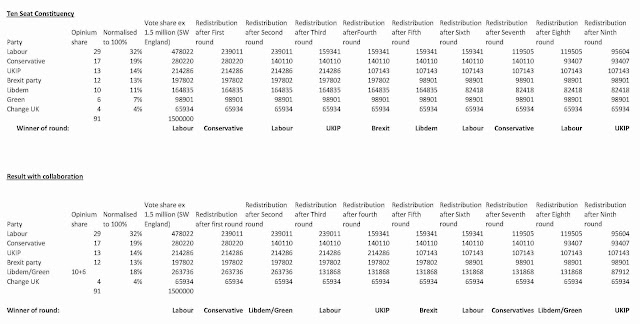Remainer Tactical Voting: Why It Matters
Opinion polls show a huge Remainer shift. Lifelong Conservatives and Labour voters are switching to parties that clearly support Remain or a Peoples’ Vote. Most are shifting to the LibDems and the Greens. And large numbers of Remainers who wouldn’t usually bother vote in an EU election are saying that they will vote.
But because the Remainer vote is split between up to four Remainer parties, we could ‘win’ on voter numbers without getting MEP seats to match. This is because of the “d’Hondt” voting system used for this election.
Under the d’Hondt voting system, we have to vote for a party, not a candidate. Our ballot papers show parties and their lists of candidates in our constituency. Outside Northern Ireland, which uses a different system, we have to vote for a single party’s list.
I hadn’t registered the D’Hondt system until recently and had no idea how it works until I saw its maths. This has huge consequences because it discriminates against parties that do not get over a threshold share of the vote. It will hit Remainer parties badly because they are splitting the big Remainer vote into small blocks.
The UK is divided into 12 constituencies with between three and ten seats each. That threshold is 10% of the votes in a large constituency like London, increasing to over 30% for a three-seater such as North East England. If your party doesn’t get over the threshold, it gets no seats at all!
The Remain vote share is large and growing, but split between up to four parties. Individual party percentages are often below that threshold. In those cases, tactical voting will be crucial. Otherwise our large and growing Remainer vote share will not turn into seats.
 |
| Example of the effects of Tactical Voting |
We can only achieve fairness through tactical voting. That said, increasing Remain voter turnout really matters because it brings a double benefit:
- Remainer voter share is an important result in itself, especially if we can resoundingly beat the Farage vote share.
- And if polls indicate Remainer turnout increasing dramatically, more of parties will get over that threshold, meaning they can get MEPs without needing tactical voting.
In Scotland and Wales, most of the Remain vote will probably go to the SNP and Plaid Cymru so the risk of the Remain vote being split is much lower. But if you are thinking of voting for another Remain party you must think about voting tactically.
In England, Remain voters are split between the LibDems, the Greens and TIG. In many constituencies, those thresholds won’t be crossed and large blocks of remain votes won’t lead to remain MEPs.
This means that Remain voters must think about voting tactically. The www.remainvoter.com website is here to make your task easier by providing constituency-level advice. If the likely Remainer vote increases dramatically, don't be surprised if the advice is sometimes to "vote with your heart" rather than voting for a party that is not your first choice.
What are the @Remainvoter ground rules? Obviously, it is pro-remain! But as between the true Remainer parties, LibDems, Greens, TIG/ChangeUK, SNP and Plaid Cymru, there is complete neutrality.
The aims are:
- To avoid undermining parties that are already likely to win a particular MEP seat; the
- To help parties close to winning a particular seat by getting supporters of parties unlikely to win a seat in that constituency to vote for the party that is closest to winning a seat.
RemainVoter will publish its main recommendation on www.remainvoter.com on 18 May.
- UK-based postal voters will have time to read its recommendations before voting, but must then post their ballot forms promptly.
- If you are voting at a polling station, please keep watching remainvoter.com from 18 May. If polls shift significantly, the recommendations may be refined before polling day on 23 May.
Declaration of interest: I am supporting @Remainvoter's work

Comments
Post a Comment